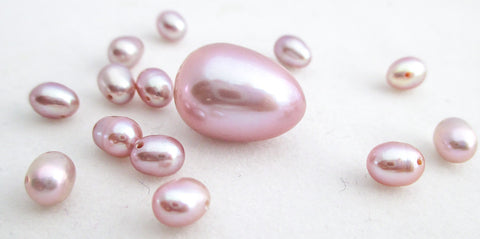Modern – Pearl & Moonstone Traditional – Alexandrite Mystical - Moonstone

Pearls, the beautiful and elegant organic gems, are unromantically but scientifically described as globular cysts of calcium carbonate (mainly aragonite, a relatively soft carbonate mineral (CaCO3) that also makes up the shells of mollusks) that form within the tissues of mollusks as nacre, a protective coating resulting from an internal irritation, such as a grain of sand. Most pearls on the market today are cultured by inserting an artificial irritant or bead into the mollusk shell to create the pearl.

Coin pearls - such as the ones in the picture above - are formed around a flat shaped bead nucleaus that causes the pearl to form around it into a coin, oval or square.

Keshi pearls are sometimes called cornflake pearls because of their unique shapes. They are usually a secondary pearl that forms as a by-product in the mollusk's mantle tissue after a cultured pearl has been removed. The nacre continues to be produced my the mollusk but because the irritant or seed pearl is not there to form around, the pearl forms in a random flat shape in the pocket left behind by the first pearl.

It's rare to see a naturally colored freshwater pearl, except for those that are creamy white. Bright white pearls have been bleached to get their nice, uniform color. Most colored pearls are first bleached and then dyed. Pearls such as the ones above were most likely not bleached before they were dyed pink. You can see their uneven natural color showing through. It's obvious that the colors in the pearls below are not natural but they are beautiful and usually retain their color, though I have seen the color of some pearls fade over time.

I remember learning at a young age that natural pearls can be distinguished from imitation pearls by a simple test. Take the pearl and rub it gently against the surface of your front teeth. Cultured and natural pearls will feel slightly gritty because of the texture of natural nacre but imitation pearls will feel smooth.

Pearls have been found in jewelry dating back to 100 BC and long beyond. According to South Asian mythology, pearls are dewdrops from heaven that fell into the sea and were caught by shellfish under the first rays of the rising sun. In India, warriors encrusted their swords with pearls to symbolize the tears and sorrow that a sword brings.
Esoteric Attributes:
| Pearl |
These Moon and Water ruled “gems” enhance sincerity, truth and loyalty.
Pearls bring centering and a calming reflection, as well as attune the wearer to the ebb and flow of life. Gives purity, promotes faith, charity and integrity, especially personal integrity. Due to its watery and lunar elements, it is balancing for the emotions, especially to water signs. Stimulates one’s femininity and assists in self acceptance, lifting one’s spirits and reminding us to stand with dignity. |
